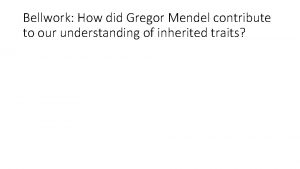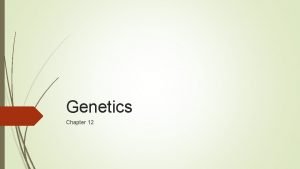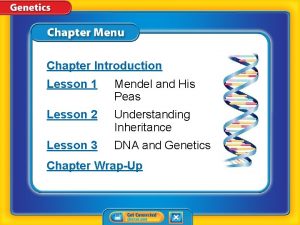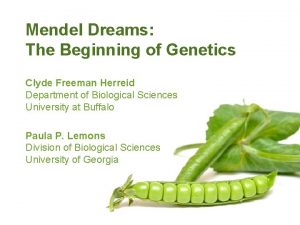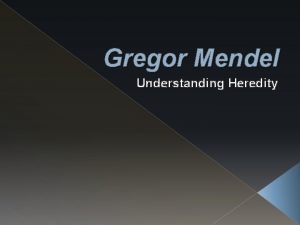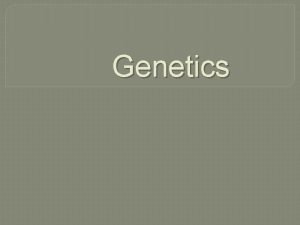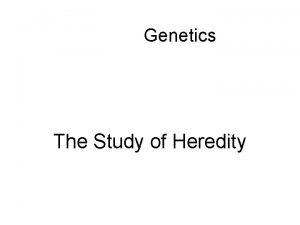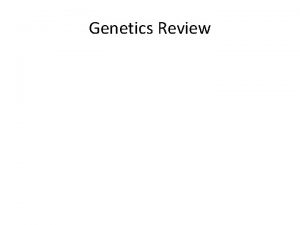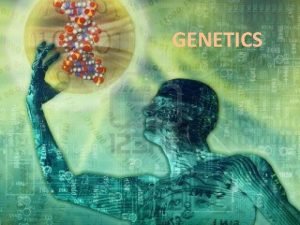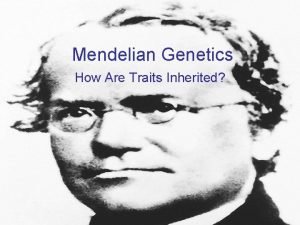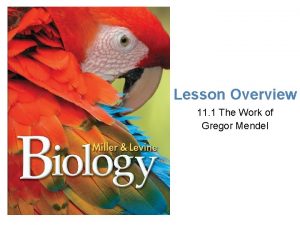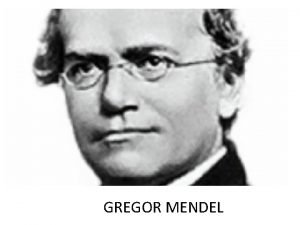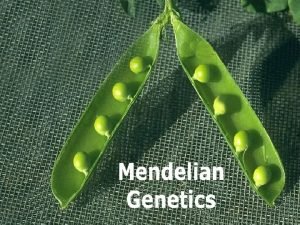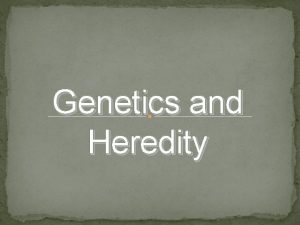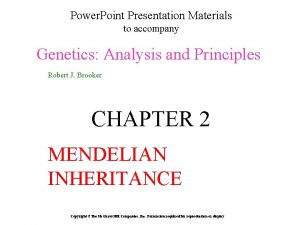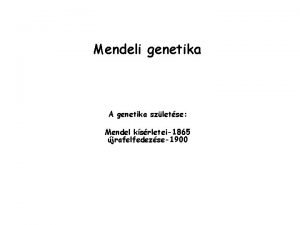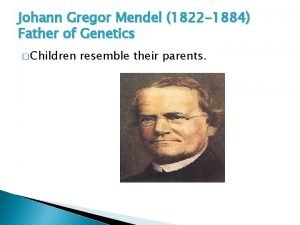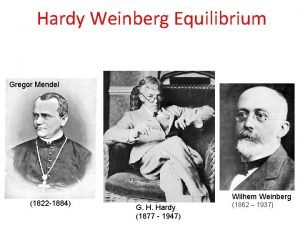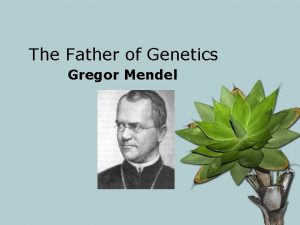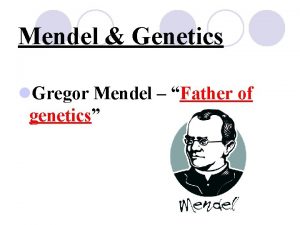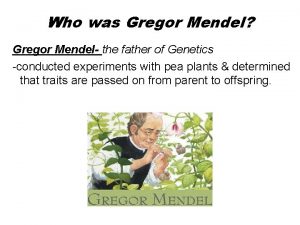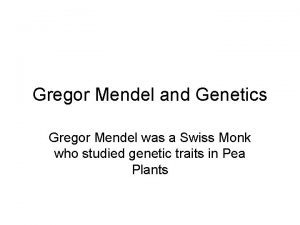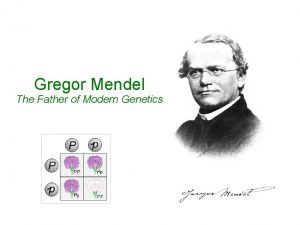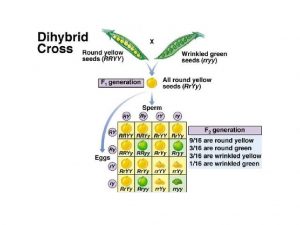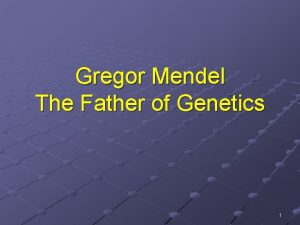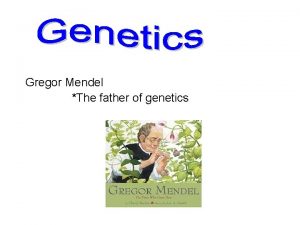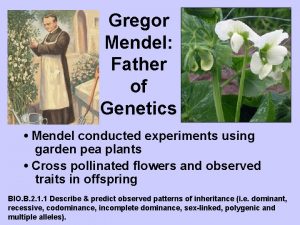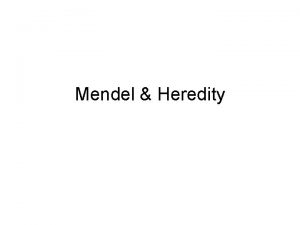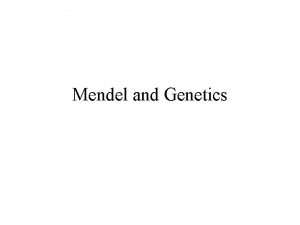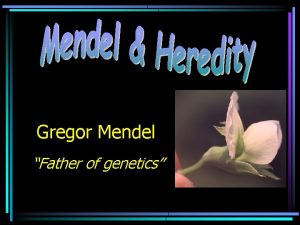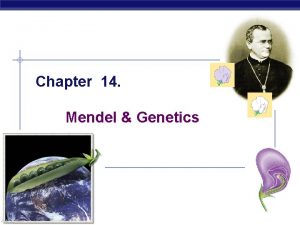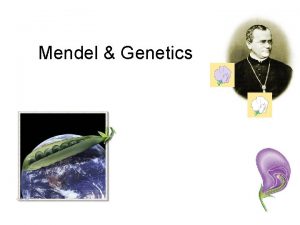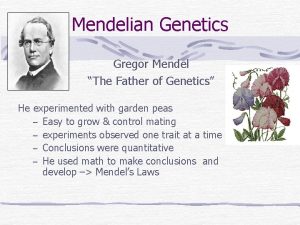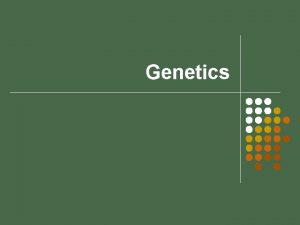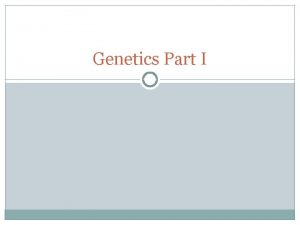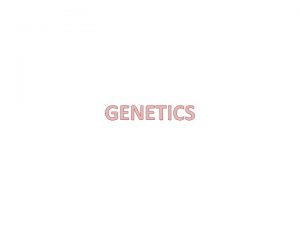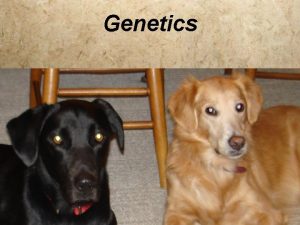Chapter 9 Introduction to Genetics Gregor Mendel Father


































- Slides: 34

Chapter 9 Introduction to Genetics

Gregor Mendel (Father of Genetics) • Was the first person to analyze patterns of inheritance • Deduced the fundamental principles of genetics Figure 9. 4

Seven characteristics of pea plants studied by Mend Dominant Recessive Pod shape Flower color Purple Inflated Constricted Green Yellow White Pod Color Flower position Axial Terminal Yellow Green Stem length Seed color Tall Seed shape short Figure 9. 7 Round Wrinkled

Mendel’s Garden Mendel studied garden peas • These plants are easily manipulated • Self-fertilize Stamen pistil Figure 9. 5

Mendel carried out some cross-fertilization Removed stamens from purple flower Parents (P 1) Pollinated ovary matured into pod White Stamens pistil Transferred pollen from stamens of white flower to pistil of purple flower Planted seeds from pod Offspring (F 1) Figure 9. 6

Cross Fertilization of Parents Pollen Cross-Fertilize Pollen P P True-breeding Purple-flowered Parent True-breeding White-flowered Parent F 1 All Purple-flowered Offspring (hybrid)

Monohybrid cross – cross between hybrids for one trait such as flower color F 1 75% Purple 25% White Self-Fertilize F 2 F 2

Genes, Alleles, Loci (specific location on a chromosome where a gene is found) and Chromosomes Chromosome from One Parent C t F Loci: 1 2 3 4 5 6 7 8 9 10 11 12 13 14 15 16 17 18 19 20 21 22 23 24 25 26 locus has gene that locus has controls gene that plant controls height. fruit shape. Plant homozygo heterozygo us us for this recessive gene for this Loci: 1 2 3 4 5 6 7 8 gene 9 10 11 12 13 14 15 16 17 18 19 20 21 22 23 24 25 26 locus has gene that controls leaf color. Plant homozygo us dominant for this gene f t Homologous Chromosome from Other Parent C


Using a Testcross to Determine an Unknown Genotype A testcross is a mating between and individual of unknown genotype and a homozygous recessive individual Testcross: Genotypes P_ pp Two possibilities for the purple flower: Pp PP Gametes P Offspring P P Pp All purple p Pp p pp 1 purple : 1 white Figure 9. 12

Rules of Probability affects inheritance (Example) • Coin toss: probability of heads = ½, the outcome of any particular toss is unaffected by what happened on previous attempts. • Each toss is an independent event • The probability of a compound event is the product of the separate probabilities of the independent events. (example: ½ x ½ = ¼) • Rule of Multiplication

The Rules of Probability F 1 Genotypes B b male B b female The rule of multiplication The probability of a compound event is the product of the separate probabilities of the independent events Formation of eggs Formation of sperm 1/ 2 B B 1/ 2 1/ B B b 1/ 1/ 2 b 4 (1/2 1/2) 2 b B 1/ 4 b F 2 Genotypes b 4 b 1/ 4 Figure 9. 13

Dihybrid Cross: Ss. Yy x Ss. Yy X Ss. Yy Eggs 1 Ss. Yy Parent 4 SY Self-fertilizes 1 SY 1 4 Key: 16 SSYY Smooth = S 1 Wrinkled = s 4 Sy 1 Yellow = Y Sperm 16 SSy. Y Green = y 1 4 s. Y 1 1 4 sy 1 4 Sy 1 16 16 s. SYY 1 16 s. Sy. Y 1 4 sy SSYy 1 16 Ss. YY 1 16 Ss. Yy SSyy 1 16 Ssy. Y 1 16 Ssyy s. SYy 1 16 ss. YY 1 16 ss. Yy s. Syy 1 16 ssy. Y 1 16 ssyy



Recombination Can Create New Combinations of Linked Alleles • Although they tend to be linked together, genes in the same chromosomes do not always stay together • Recombination occurs due to crossing over • Crossing over during Meiosis explains the appearance of new combinations






Family Pedigrees Mendel’s principles apply to the inheritance of many human traits Dominant Traits Recessive Traits Freckles No freckles Widow’s peak Straight hairline Free earlobe Attached earlobe Figure 9. 14

Multiple Alleles: • • • Traits that are expressed by more than two alleles Alleles arise through mutations, and the same gene in different individuals may have different mutations, each producing a new allele You can find dozens of alleles for every gene Most genes have multiple alleles rather that just two Examples: Blood types

Polygenic Inheritance • • Interactions of many genes. Alleles at several even many sites on a chromosome affect each characteristic. Not governed by a single gene Interactions of two or more genes contribute to a single phenotype Example: Eye color • • • The color of the human iris varies from pale blue through green to almost; black Blue = little or no pigment Green, brown, hazel, and black (have more pigment, have genes that direct the production of more melanin


Environmental Influences • An organism is not just the sum of it’s genes, in addition to genotype, the environment in which an organism lives affects it’s phenotype • Example: Himalayan Rabbit • • skin color, and human intelligence (identical twins raised in different environments, have different IQ”s)


Himalayan Rabbit

Incomplete Dominance: • Inheritance in which, an active allele does not entirely compensate for an inactive allele • When the heterozygous is intermediate between the two homozygous phenotypes • Example: Carnations and snap dragons


Codominance: • Condition in which both alleles of a gene are expressed • Both phenotypes are expressed in heterozygous • Example: Hair color in cows and sickle Cell anemia

Co-dominance

Co-dominance

Co-dominance
 Pp x pp
Pp x pp Gregor mendel’s principles of genetics apply to
Gregor mendel’s principles of genetics apply to How did gregor mendel contribute to genetics
How did gregor mendel contribute to genetics Chapter 12 lesson 1 the work of gregor mendel
Chapter 12 lesson 1 the work of gregor mendel Chapter 12 lesson 1 the work of gregor mendel
Chapter 12 lesson 1 the work of gregor mendel Chapter 11 the work of gregor mendel
Chapter 11 the work of gregor mendel Mendel and his peas lesson 1
Mendel and his peas lesson 1 Who is gregor mendel and what is he famous for
Who is gregor mendel and what is he famous for Section 11-1 the work of gregor mendel
Section 11-1 the work of gregor mendel Who is gregor mendel
Who is gregor mendel Gregor mendel's dream was to?
Gregor mendel's dream was to? Gregor mendel chart
Gregor mendel chart Suit separate
Suit separate What did gregor mendel research
What did gregor mendel research What did gregor mendel do
What did gregor mendel do What did gregor mendel do
What did gregor mendel do Gregor mendel conclusions
Gregor mendel conclusions Gregor mendel punnett square
Gregor mendel punnett square Gregor mendel plant
Gregor mendel plant Gregor mendel laws
Gregor mendel laws Gregor mendel summary
Gregor mendel summary Johann sebastian bach lebenslauf
Johann sebastian bach lebenslauf Law of segregation anaphase 1
Law of segregation anaphase 1 Who is gregor mendel and what did he do?
Who is gregor mendel and what did he do? Gregor mendel referat
Gregor mendel referat Gregor mendel
Gregor mendel ____________is the austrian monk who experimented with
____________is the austrian monk who experimented with Mendel traits
Mendel traits Gregor mendel laws
Gregor mendel laws Gregor mendel laws
Gregor mendel laws Tesztelő keresztezés
Tesztelő keresztezés Gregor mendel 1865
Gregor mendel 1865 Gregor mendel
Gregor mendel Mendel equilibrium
Mendel equilibrium What is the phenotype of a chicken with the genotype fbfw?
What is the phenotype of a chicken with the genotype fbfw?


